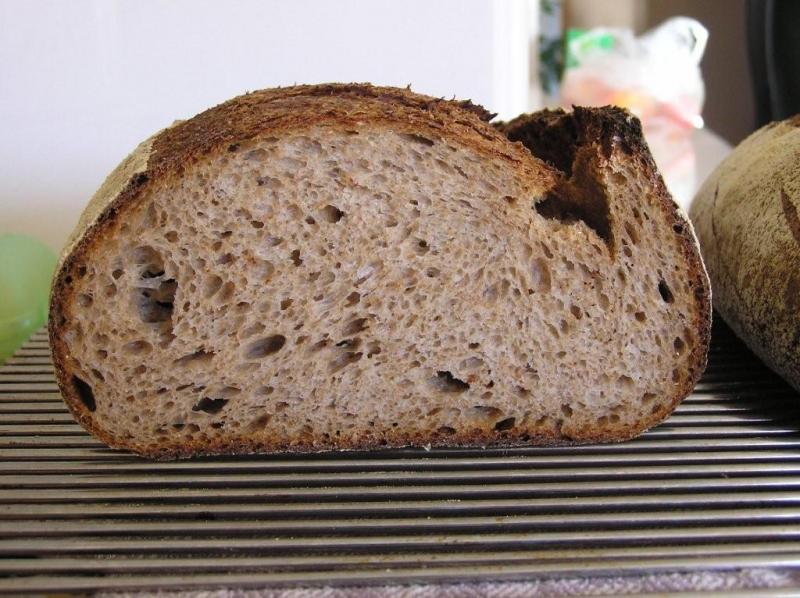I like a nice airy crumb, but also like the idea of whole wheat in bread. I find that 100% WW loaves are too dense (if I understand it correctly, the protein from the bran cuts gluten chains).
Any suggestions how much WW flour can be used while maintaining a loose, airy, crumb structure?
Len Marquart in Whole Grains and Health had a whole wheat loaf which included whole wheat and aleurone flours. It rose as high as, or nearly as high as, white bread. In his formula he used 100% whole wheat flour, added 20% aleurone flour, and mono- and di-glycerides at 2% of the whole wheat flour.
Hi,
this is 85% WW + 15% Bread flour - sourdough bread (without commercial yeast).
txfarmer you can do 100% whole grains and get twice an open crumb of dabrownman at 30%. I think it is all in the small light fingers only Empresses have:-)
My contribution to 100% WW. Light and fluffy.
http://staffoflife.wordpress.com/2013/05/17/commercial-style-wholemeal-loaf/
Hi Michael,
What a remarkable crumb on 100% ww. Wonderful soft crumbs seem to be your trademark with any flour you bake with!
How did you come up with the formula - especially the egg yolk %. Did you retard the dough at all? I am thinking it had to be a pretty loose dough at 80% HL even for ww plus the 10% fat. All adding up to a very soft crumb indeed.
One last question...How long did you knead the dough?
Thanks,
Janet
Hi Janet.
The dough wasn't at all loose and could certainly have benefited with more hydration or some soaking. My Italian style sourdough makes dough firmer and drier because of the introduced acidity. Plus this wholemeal flour is very absorbent anyway. This was a quickly made loaf (I forgot to mention I used fresh yeast as well - the sourdough is purely an improving agent).
I used the egg yolk for it's emulsifying properties (3% happens to be one yolk for the yield I made). I find this makes the loaf perform better when being toasted. It suppresses any coarseness that tends to occur due to intensive kneading.
I kneaded to achieve full development. In the machine and then finished by hand a la bertinet. Ten, fifteen minutes by hand perhaps...
Cheers,
Michael
Hi Michael,
Thanks for the response and explanation. When I looked at the formula fresh yeast isn't in your list of ingredients. Knowing that you did use some (what % did you use?) the crumb makes sense. I have tried with my leaven to make high rising loaves like this and I can do it but to get a crumb that looks like yours I do find I have to use IY too. I generally add .1%.
I have tried using YW to get the same results and it simply does not do the same thing. Sweetens and moistens but doesn't produce a crumb like yours with my whole wheat.
Thanks again.
Janet
Both of the loaves are awesome for wholemeal - well done!
Perhaps you will be willing to share the recipes with us - mwilson I can see yours on the blog...
Recently baked the whole wheat Tartine country loaf that came out with a nice open crumb for a whole wheat loaf.
<a href="http://www.flickr.com/photos/suewoo/8750656185/" title="Whole Wheat Tartine Bread by sfwooss, on Flickr"><img src="http://farm9.staticflickr.com/8137/8750656185_deca72dafb_n.jpg" width="320" height="240" alt="Whole Wheat Tartine Bread"></a>
I think the answer depends partly on your skill and technique. It's possible to get a good airy crumb with 100%WW as the above posters demonstrate, but IMO it's more difficult. One thing to do is ensure adequate hydration. A mistake that is probably common is to just substitute whole wheat for regular flour without taking into account the higher water absorption of the WW. You also need to be careful to ensure adequate gluten development, good shaping, and perfect proofing.
The addition of a bit of vital wheat gluten can also help.
Peter Reinhart's rule of thumb for substituting whole grain flour for white:
For substitutions up to 10% no added liquid is needed. If you want to exchange more than 10%:
Increase water by 14 g for every 56.5 g whole grain flour you substitute for white flour
Karin